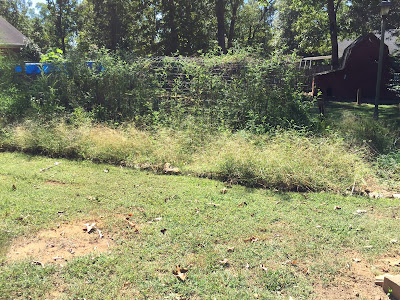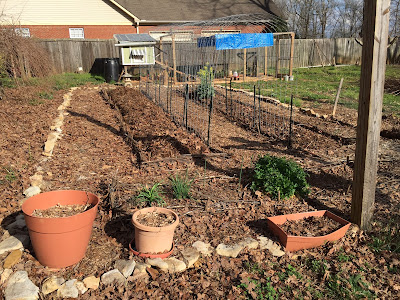DAY 1
 |
| My beautiful weed garden! |
I gave up at some point during the summer after harvesting beans one or two good times. Weeds sprung up and celebrated at my retreat. However, the word retreat is not quite fair as I have been working 7 days a week most of the time. The occasional day off was either due to a holiday or birthday and my garden doesn't get one of those, so it got neglected. My work has been a unique kind of struggle lately and I had the opportunity to be off two days in a row. Ergo, my garden got the spa treatment with a complete make-over. My initial plan was that I was going to reduce my garden from 3 beds down to 1 and build a rock wall out of the border that lined my overgrown garden.
Not sure if I'm alone in this challenge, but I started out with a simple plan and it turned into a million other things. Either I was procrastinating or my ADHD got the best of me as I started pruning my peach trees right after I set out to tackle the garden.
My accomplishments after day 1 was getting rid of most of the weeds from the garden and pruning the peach trees. After raking and pulling at weeds for an hour, I caved in and spent $30 on a cheap weed eater so I could save myself from a rough night of sleep. Not to mention that I'm not a fan of blisters. You know what I mean if you have ever raked leaves for an hour or so.
 |
| 5 hours of work and I was beat! |
DAY 2
 To start off Day 2, I finished adding the rest of the rocks to the border of my now solo garden. It took a few hours, but I was feeling the magic. After the rock border was complete, I positioned my St. Francis of Assisi statue within the border which looked beautiful. Everything just came together! Now it was time to add dirt, LOTS OF DIRT! All of the dirt I used came from the two beds that I removed. The dirt was nitrogen rich as I grew mostly beans throughout the garden this year. Correction, I grew mostly weeds, but I'm hoping there was some nitrogen remaining after the weeds went on their extended vacation.
To start off Day 2, I finished adding the rest of the rocks to the border of my now solo garden. It took a few hours, but I was feeling the magic. After the rock border was complete, I positioned my St. Francis of Assisi statue within the border which looked beautiful. Everything just came together! Now it was time to add dirt, LOTS OF DIRT! All of the dirt I used came from the two beds that I removed. The dirt was nitrogen rich as I grew mostly beans throughout the garden this year. Correction, I grew mostly weeds, but I'm hoping there was some nitrogen remaining after the weeds went on their extended vacation.
Next came on the task of adding all of the leaf mulch so that there would be something yummy for the plants to eat next spring.
 |
| That is a lot of leaves and it will be wonderful by next year! Save your leaves! |
Then I had the idea of covering the garden with a tarp so that it wouldn't grow any weeds. My other thought is that it would help the leaves compost quicker so that next spring I'll have some top notch soil. I went to Home Depot looking for a tarp and found something cheaper and better. A black plastic sheet! I used the rocks to hold it down and I am happy with the end result. I ended up using an old tarp for some of the garden as my black sheet did not quite meet the bill.
While I was at Home Depot, I picked a few steel rods and some cheap pvc piping to make a small green house that my tropical plants and seedlings need to survive the winter. Last winter my lemon plants lost every single leaf, which was scary. I'm hopeful this winter will be easier on my fig seedlings, pineapple plants, avocado seedling, and lemon plants. The green house was easy to make, although it looks a little sloppy, it should do the trick. It will be cramped in there for my plants, but they'll fit!
Keeping my fingers crossed and I hope this will hold me over until Spring of next year!



















































